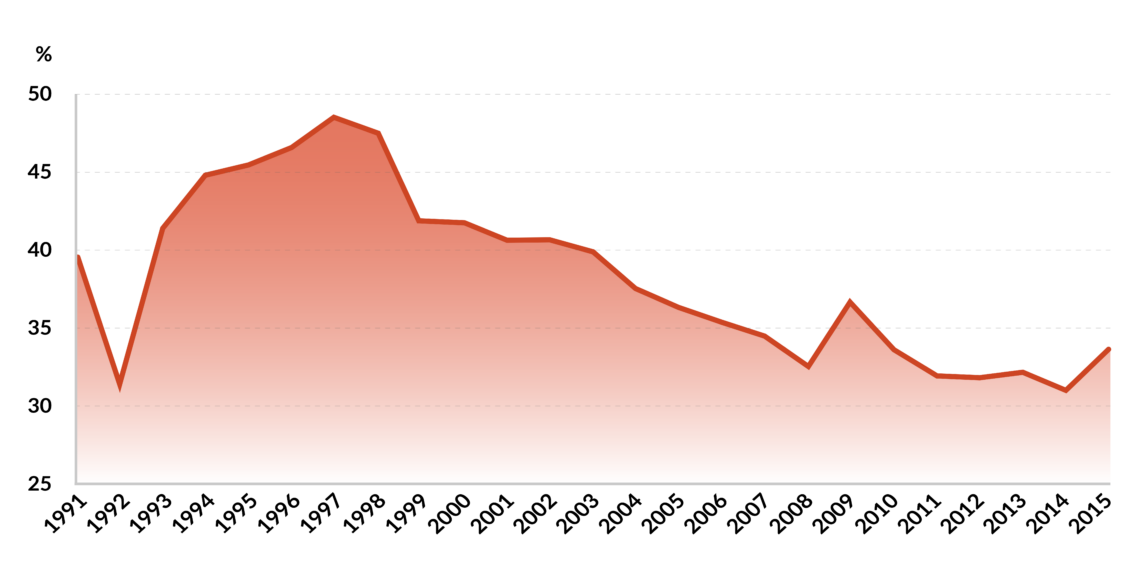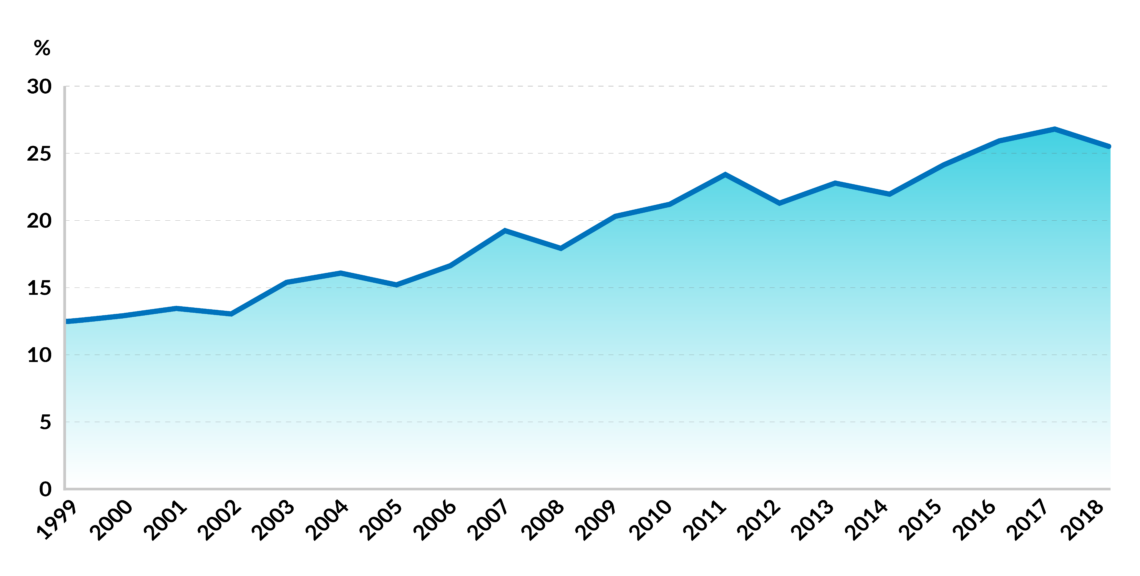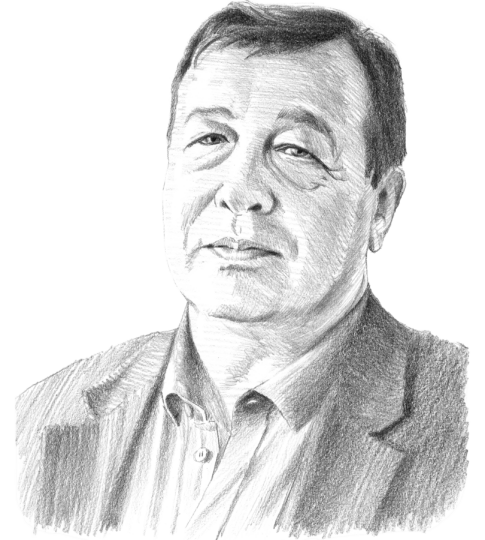Assessing the shadow economy in Russia
While it is difficult to precisely assess the size of Russia’s informal sector, most experts agree that it accounts for a sizable percentage of the country’s economic activity. The phenomenon is rooted in long-standing structural issues that could be addressed by reforms.

In a nutshell
- Russia’s shadow economy makes up over a fourth of its GDP
- Lack of opportunities leads workers to look for alternatives
- Legalizing the informal sector would require in-depth reforms
In any country, there is a so-called “gray” or informal economy. But in the case of Russia, the phenomenon reveals much about the quality of public administration and institutions.
Experts differ greatly when it comes to calculating the size of the Russian informal sector. It includes, on one hand, business activity that is not officially registered and therefore not subject to taxes and other mandatory payments, as well as cash payment of salaries at enterprises that work legally. On the other, there are criminal activities – drug and arms trafficking, prostitution, pornography, and smuggling (including avoiding paying customs duties).
Varying numbers
Official estimates of the size of Russia’s gray economy consider only activities permitted by law. These include unofficial labor and paying salaries “under the table,” legal but unregistered production and households’ production of goods, for example growing vegetables for sale or for their own consumption. The Russian authorities do not include criminal activity in the calculation, although the international standard of the System of National Accounts recommends that it be included.
In 2019, 14.8 million people were informally employed.
Based on this approach, the volume of the Russian gray economy in 2018, according to the governmental Federal Financial Monitoring Service, was 20 percent of the gross domestic product (GDP). The State Statistics Office gives a much smaller estimate – 12.7 percent of GDP in 2017. The difference is due to the fact that the federal monitoring service takes into account gray imports (false import declarations to avoid customs duties), concealing income from tax and customs authorities, as well as undeclared salaries.
The International Monetary Fund (IMF) also has its own methodology for assessing the shadow economy. Looking only at legal activities, the IMF estimates that it accounted for 38.42 percent of the Russian economy in 2015. Among the 158 countries covered in this study, Russia ranks 109. However, there is clear progress compared to the 1990s. Meanwhile, the experts behind the website Stat.Russ depict a different trend and believe the share of the gray economy in Russia’s GDP rose in recent years.
Facts & figures

Employment trends
The Russian statistics service reports that in 2019, 14.8 million people (20.6 percent of the workforce) were informally employed, compared to 11.5 million in 2010. A small number (less than one million people) work simultaneously in the formal and informal sectors. According to the Center for Socio-Political Monitoring at the RANEPA state university, the shadow labor market in 2017 included 30 million people (more than 40 percent of the economically active population). This number includes 21.7 million people who received undeclared earnings while working legally.
When the Covid-19 pandemic was raging, informal employment in Russia increased.
In 2019, a survey of 2.4 million companies by the Federal Tax Service revealed that 56 percent had either zero or one employee, meaning most of them hire workers without registering them. In 2020, when the Covid-19 pandemic was raging, informal employment in Russia increased. The share of workers employed only in this sector increased from 17.9 percent in the second quarter to 18.9 percent in the fourth quarter. At the beginning of the crisis, most job losses were part of the shadow economy. But in the second half of the year, most new jobs created were in the informal sector.
Causes and solutions
In a survey, every second citizen of the Russian Federation reported having resorted to the shadow market to obtain services (education, medicine, car repairs, etc.) in the past month. Why do Russians remain in the informal economy, which, if we consider only permitted activities, covers at least 25-30 percent of GDP? They seek to avoid excessive state regulation and the resulting corruption, as well as high taxes. The large shadow sector in Russia is also a consequence of the lack of stable legislation in the economic sphere, especially concerning taxation and other fees.
However, the main reason behind this phenomenon is the archaic structure of the Russian economy, whose main sector (with relatively high salaries) remains the extraction of mineral raw materials. Yet in 2020 only 2.3 percent of the labor force was employed there. Other sectors of the economy offer very few well-paid legal jobs, leading people to look for other opportunities.
There are considerable differences between Russian regions. In 2018, the highest informal employment was observed in the republics of the North Caucasus – 64 percent in Chechnya, 52 percent in Dagestan, and 48 percent in both Ingushetia and Kabardino-Balkaria. In addition, roughly a third of the population works unofficially in the republics of Adygea, Altai, Astrakhan, Buryatia, Ivanovo, Kalmykia, Karachay-Cherkessia, North Ossetia and the areas of Astrakhan, Krasnodar and Stavropol.
Facts & figures

These geographic discrepancies are not accidental. The regions where informal employment is the highest are also the least developed. In 2018, the poorest Russian territories had a gross regional product almost 62 times smaller than the richest areas. There are also cultural and historical factors at play, since these locations are mainly autonomous ethnic republics. Another reason is the lack of an effective territorial development policy. Measures set out by the federal government regularly go unimplemented. The last strategy was adopted in 2019 and covers the period up to 2025. Judging by the interim results, it awaits the same fate.
If the state acts through force, there would be significant negative consequences.
Legalizing at least part of the Russian gray economy would be possible only by implementing large-scale institutional reforms. Speaking this year at a St. Petersburg economic forum attended by nearly the entire federal government, public ombudswoman for small and medium-sized businesses Anastasia Tatulova described the current interaction between the state and business: “You spit on us … and we hate you.” If reforms to improve trust levels are not undertaken, it is difficult to imagine how the shadow economy could be legalized in a way acceptable to Russian citizens. If the state acts through force, there would be significant negative consequences.
The income level of the majority of the informally employed would decline, and their living standards would drop noticeably. Enterprises would go bankrupt because of the increased fiscal burden. Unemployment would rise sharply, since the legal economy does not have enough jobs to accommodate the more than 14 million people working in the gray sector.








